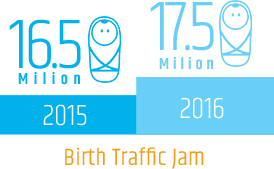China’s Switching From One Child to Second Child Policy, and Its Influence on the Infant Formula Market
It stands to reason that more babies means higher demand for formula, so last year’s decision by the Chinese government to relax its decades-old one child policy, and allow second child policy, has been the source of considerable excitement among manufacturers.

The policy of restricting most couples to one child was implemented in 1979 for sound demographic reasons. At that time there were serious concerns about the rate of population growth, and the impact it would have on national resources – particularly food.
But its consequences included an ageing population and a shrinking workforce. In 2014 it was relaxed, and the following year the Government end its one child policy, and adopted a universal two-child policy, which came into force at the start of 2016. That has been accompanied by other measures to support larger families, such as tax perks and enhanced maternity rights.
Those who predicted a “baby boom” appear to have been vindicated by the latest figures. In the first half of 2016, 8.31 million newborns were registered nationally. And of those, 44.7% were second children – up from 37.9% for the whole of 2015 and the highest since the single child policy was introduced.
 In December, the Deputy Director of China’s National Health and Family Planning Commission, said the number of births in2016 would be likely to be around 17.5 million – 5.7% higher than in 2015.
In December, the Deputy Director of China’s National Health and Family Planning Commission, said the number of births in2016 would be likely to be around 17.5 million – 5.7% higher than in 2015.
According to some predictions the higher birth rate could see the Chinese population peaking at 1.45 billion by 2029 (180 million higher than the projected figure had the one-child policy remained in place) and the workforce growing by 30 million. In the shorter term, one of the effects has been a “birth traffic jam”, with families racing against biological clocks to take advantage of the policy.

So what does changing the one child policy mean for the infant formula market?
 Initially, the signs for child-focused markets overall were extremely positive. In August, it was reported that seven of the top Chinese baby-related businesses had seen a 100 percent increase in net profits, with three reporting 300 percent growth in revenues.
Initially, the signs for child-focused markets overall were extremely positive. In August, it was reported that seven of the top Chinese baby-related businesses had seen a 100 percent increase in net profits, with three reporting 300 percent growth in revenues.
Some more recent reports have painted a less optimistic picture, with the biggest brands reporting relatively small increases in sales. Yet this does not necessarily reflect a lack of demand and is likely to have more to do with recent regulatory changes that have affected sales: there has been a crackdown on the process of selling through third parties and all importers are required to register with the Chinese authorities by December 2017.
It is still early days, and manufacturers are unlikely to see the full benefit of the “baby boom” for some time. However, according to Euromonitor, we should still see a 6% growth in the next years, and in our opinion the outlook for the infant formula market is very bright.
